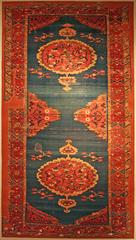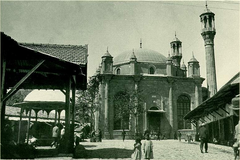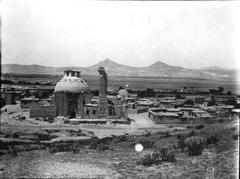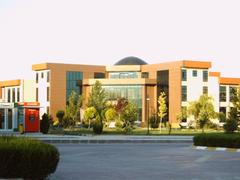
Konya Archaeological Museum: Visiting Hours, Tickets, and Historical Sites Guide
Date: 04/07/2025
Introduction
The Konya Archaeological Museum is one of Turkey’s oldest and most significant archaeological museums, offering a comprehensive exploration of Anatolia’s rich history. Situated in the Meram district of Konya, the museum presents a meticulously curated journey through millennia, with artifacts spanning from the Neolithic era—highlighted by finds from the UNESCO World Heritage Site of Çatalhöyük—through the Byzantine, Seljuk, and Ottoman periods. Its collections, educational programs, and proximity to other essential Konya historical sites make it a must-visit for travelers, students, and history enthusiasts alike (muze.gov.tr, whichmuseum.com, travel-tramp.com).
Table of Contents
- Historical Development of the Konya Archaeological Museum
- Architectural Features and Collections
- Visitor Information: Hours, Tickets, Accessibility
- Highlights and Must-See Exhibits
- Nearby Historical Sites
- Preservation and Educational Role
- Frequently Asked Questions (FAQ)
- Practical Tips for Visitors
- References
Historical Development of the Konya Archaeological Museum
Early Foundations and Growth
Founded in 1901, the Konya Archaeological Museum was initially established in the Karma Secondary School, reflecting the Ottoman Empire’s early efforts to protect Anatolia’s archaeological heritage. As the collection grew, it was temporarily relocated to the Mevlana Museum in 1927 and then to the historic İplikçi Mosque in 1953. The current dedicated building opened in 1962, designed specifically to showcase and preserve the expanding array of artifacts from Konya and its surroundings (muze.gov.tr, whichmuseum.com).
Evolution and Significance
Today, the museum’s collection spans the Neolithic to the late Ottoman era, with an emphasis on artifacts from Çatalhöyük, Süberde, Erbaba, Karahöyük, and other major regional sites. These collections document the continuous habitation and cultural evolution of Central Anatolia, emphasizing Konya’s role as a crossroads in ancient trade networks, including the Silk Road.
Architectural Features and Collections
Location and Structure
The museum is located at Sahibiata Cd. No:91 in Konya’s Meram district, nestled within the historical core of the city. Its modernist mid-20th-century design features spacious galleries, climate control, and ample natural light to protect and display sensitive artifacts.
Exhibition Layout
The museum is arranged into chronological and thematic galleries:
- Prehistoric Section: Artifacts and figurines from Neolithic sites, notably Çatalhöyük, plus Early Bronze Age tools and pottery from Sızma and Karahöyük.
- Iron Age and Classical Halls: Phrygian and Urartian ceramics, Hittite relics, and Classical Greek vessels.
- Roman and Byzantine Galleries: Marble sarcophagi, sculptures, mosaics—including the impressive 6th-century Tatköy Church floor mosaic—and Christian relics.
- Seljuk and Ottoman Section: Glazed ceramics, metalwork, and architectural fragments from Konya’s medieval Islamic history.
Outdoor Exhibits
The museum’s garden and portico display monumental stonework, including Roman sarcophagi, grave stelae, and early Christian inscriptions from sites visited by St. Paul, underlining the region’s diverse historical layers (muze.gov.tr).
Visitor Information: Hours, Tickets, Accessibility
Visiting Hours
- Tuesday to Sunday: 09:00 – 17:00 (or 17:30 in summer)
- Closed: Mondays and national holidays
- Note: Hours may shift seasonally; check the museum’s official website or local tourism offices before your visit.
Tickets and Admission
- Admission: Free of charge for all visitors (whichmuseum.com).
- No advance booking required.
Accessibility
- The museum’s entrance and main galleries are generally accessible, though some areas may have uneven floors due to the building’s age.
- Assistance is available; visitors with specific needs are encouraged to contact the museum in advance.
Highlights and Must-See Exhibits
- Mother Goddess Figurines: Rare Neolithic clay statuettes embodying Anatolian spirituality.
- Tatköy Church Mosaic: A 6.3 x 3.5 m Byzantine floor mosaic from the 6th century, a focal point of the Byzantine gallery.
- Heracles Sarcophagus: A Roman masterpiece intricately carved with mythological reliefs.
- Phrygian and Hittite Ceramics: Illustrating the region’s artistic and cultural diversity.
- Roman Sculptures and Sarcophagi: Displayed in the museum’s tranquil outdoor courtyard.
- Seljuk and Ottoman Ceramics: Glazed pottery and tiles reflecting medieval Konya’s history.
Nearby Historical Sites
The museum’s central location makes it ideal for exploring other key Konya historical attractions:
- Mevlana Museum: Mausoleum of the renowned Sufi poet Rumi.
- Alaaddin Mosque: A landmark of Seljuk architecture.
- Çatalhöyük: The world’s oldest known urban settlement, a short drive from the city.
- Sille Village and Ince Minare Museum: Offering further insight into the region’s diverse heritage (travel-tramp.com).
Preservation and Educational Role
The museum employs advanced conservation practices, including climate control and security systems, to preserve its diverse collections. As a research hub, it collaborates with universities and archaeological teams to integrate new discoveries and supports community engagement through educational programs, guided tours, and special exhibitions (muze.gov.tr).
Frequently Asked Questions (FAQ)
Q: What are the museum’s visiting hours?
A: Tuesday–Sunday, 09:00–17:00 (closed Mondays and public holidays).
Q: Is there an entrance fee?
A: Admission is free.
Q: Are guided tours available?
A: Yes, inquire at the museum desk or arrange in advance; private guides can also be booked via local tour operators.
Q: Is the museum wheelchair accessible?
A: Most main areas are accessible, but some older sections may have uneven flooring.
Q: Can I take photographs inside?
A: Photography is allowed (without flash); please respect signage and exhibit boundaries.
Q: What is the best time to visit?
A: Mornings or late afternoons are quieter; afternoons (2 PM–3 PM) tend to be busiest.
Practical Tips for Visitors
- Allocate at least one hour for a comprehensive visit.
- Use a guidebook or translation app for detailed information, as most signage is in Turkish.
- Dress modestly, respecting local customs.
- Combine your trip with nearby attractions for a full day of discovery.
- Nearest dining options and cafés can be found within walking distance in the city center.
- For updates on special exhibitions or events, follow the museum’s official website or local tourism resources.
References
- Konya Archaeological Museum (muze.gov.tr)
- Museum Details (whichmuseum.com)
- Things to Do in Konya (travel-tramp.com)
- TripHobo Guide
- Ways of the World Blog
Plan Your Visit
Immerse yourself in the ancient and diverse heritage of Anatolia at the Konya Archaeological Museum. To enhance your experience, download the Audiala app for offline audio guides, check the latest updates on visiting hours and exhibitions, and discover more about Konya’s archaeological riches through our related articles and social media platforms.








